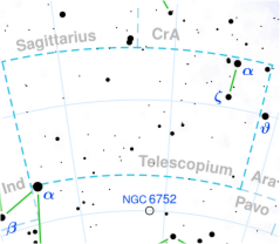Astronomy:HD 174500
| Observation data Equinox J2000.0]] (ICRS) | |
|---|---|
| Constellation | Telescopium |
| Right ascension | 18h 52m 59.90009s[1] |
| Declination | −46° 35′ 10.7923″[1] |
| Apparent magnitude (V) | 6.16±0.01[2] |
| Characteristics | |
| Evolutionary stage | subgiant[3] |
| Spectral type | A1 IV/V[4] |
| U−B color index | +0.05[5] |
| B−V color index | +0.04[5] |
| Astrometry | |
| Radial velocity (Rv) | 35.1±1.7[6] km/s |
| Proper motion (μ) | RA: +3.439[1] mas/yr Dec.: +10.006[1] mas/yr |
| Parallax (π) | 4.7156 ± 0.035[1] mas |
| Distance | 692 ± 5 ly (212 ± 2 pc) |
| Absolute magnitude (MV) | −0.82[7] |
| Details | |
| Mass | 3.00±0.09[1] M☉ |
| Radius | 5.05±0.26[8] R☉ |
| Luminosity | 273+57−47[3] L☉ |
| Surface gravity (log g) | 3.47+0.08−0.05[9] cgs |
| Temperature | 9,594+134−132[3] K |
| Metallicity [Fe/H] | +0.02[10] dex |
| Rotational velocity (v sin i) | 214[11] km/s |
| Age | 370[12] Myr |
| Other designations | |
| Database references | |
| SIMBAD | data |
HD 174500, also designated as HR 7097 or rarely 34 G. Telescopii, is a solitary white-hued star located in the southern constellation Telescopium. It has an apparent magnitude of 6.16,[2] placing it near the limit for naked eye visibility. Gaia DR3 parallax measurements place the object 692 light years away,[1] and it is currently receding with a heliocentric radial velocity of 35 km/s.[6] At its current distance, HD 174500's brightness is diminished by 0.39 magnitudes due to interstellar dust.[14] It has an absolute magnitude of −0.82.[7]
HD 174500 has a stellar classification of A1 IV/V,[4] indicating that it is an evolved A-type star with the blended luminosity class of a subgiant and a main sequence star. It has 3 times the mass of the Sun[1] and an enlarged radius of 5.05 R☉.[8] It radiates 273 times the luminosity of the Sun from its photosphere at an effective temperature of 9,594 K.[3] At the age of 370 million years HD 174500 is currently on the subgiant track and is 1.8% past its main sequence lifetime.[3] Like many hot stars it spins rapidly, having a projected rotational velocity of 214 km/s.[11] It has a solar metallicity with [Fe/H] = +0.02.[10]
This object is located close to the 5th magnitude star HD 174387. However, they do not form a double star.
References
- ↑ 1.0 1.1 1.2 1.3 1.4 1.5 1.6 Vallenari, A. et al. (2022). "Gaia Data Release 3. Summary of the content and survey properties". Astronomy & Astrophysics. doi:10.1051/0004-6361/202243940 Gaia DR3 record for this source at VizieR.
- ↑ 2.0 2.1 Høg, E.; Fabricius, C.; Makarov, V. V.; Urban, S.; Corbin, T.; Wycoff, G.; Bastian, U.; Schwekendiek, P. et al. (March 2000). "The Tycho-2 catalogue of the 2.5 million brightest stars". Astronomy and Astrophysics 355: L27–L30. ISSN 0004-6361. Bibcode: 2000A&A...355L..27H.
- ↑ 3.0 3.1 3.2 3.3 3.4 Zorec, J.; Royer, F. (January 2012). "Rotational velocities of A-type stars IV: Evolution of rotational velocities". Astronomy & Astrophysics 537: A120. doi:10.1051/0004-6361/201117691. ISSN 0004-6361. Bibcode: 2012A&A...537A.120Z.
- ↑ 4.0 4.1 Houk, Nancy (1978). Michigan catalogue of two-dimensional spectral types for the HD stars: Declinations −53° to −40°. 2. Bibcode: 1978mcts.book.....H.
- ↑ 5.0 5.1 Alexander, J. B. (1972). "UBV observations of the RR Lyrae variable HD 176387 (MT Telescopii).". Royal Greenwich Observatory Bulletins 174: 107. Bibcode: 1972RGOB..174..107A.
- ↑ 6.0 6.1 Kharchenko, N.V.; Scholz, R.-D.; Piskunov, A.E.; Röser, S.; Schilbach, E. (November 2007). "Astrophysical supplements to the ASCC-2.5: Ia. Radial velocities of ~55000 stars and mean radial velocities of 516 Galactic open clusters and associations". Astronomische Nachrichten 328 (9): 889–896. doi:10.1002/asna.200710776. ISSN 0004-6337. Bibcode: 2007AN....328..889K.
- ↑ 7.0 7.1 Anderson, E.; Francis, Ch. (May 2012). "XHIP: An extended hipparcos compilation". Astronomy Letters 38 (5): 331–346. doi:10.1134/S1063773712050015. ISSN 1063-7737. Bibcode: 2012AstL...38..331A.
- ↑ 8.0 8.1 Kervella, P.; Thévenin, F.; Di Folco, E.; Ségransan, D. (October 2004). "The angular sizes of dwarf stars and subgiants". Astronomy & Astrophysics 426 (1): 297–307. doi:10.1051/0004-6361:20035930. ISSN 0004-6361. Bibcode: 2004A&A...426..297K.
- ↑ Stassun, Keivan G. et al. (9 September 2019). "The Revised TESS Input Catalog and Candidate Target List". The Astronomical Journal 158 (4): 138. doi:10.3847/1538-3881/ab3467. Bibcode: 2019AJ....158..138S.
- ↑ 10.0 10.1 Anders, F. et al. (February 2022). "Photo-astrometric distances, extinctions, and astrophysical parameters for Gaia EDR3 stars brighter than G = 18.5". Astronomy & Astrophysics 658: A91. doi:10.1051/0004-6361/202142369. ISSN 0004-6361. Bibcode: 2022A&A...658A..91A.
- ↑ 11.0 11.1 Royer, F.; Gerbaldi, M.; Faraggiana, R.; Gómez, A. E. (January 2002). "Rotational velocities of A-type stars. I. Measurement of vsini in the southern hemisphere". Astronomy & Astrophysics 381 (1): 105–121. doi:10.1051/0004-6361:20011422. ISSN 0004-6361. Bibcode: 2002A&A...381..105R.
- ↑ Gontcharov, G. A. (November 2012). "Spatial distribution and kinematics of OB stars". Astronomy Letters 38 (11): 694–706. doi:10.1134/S1063773712110035. ISSN 1063-7737. Bibcode: 2012AstL...38..694G.
- ↑ "HD 174500". SIMBAD. Centre de données astronomiques de Strasbourg. http://simbad.u-strasbg.fr/simbad/sim-basic?Ident=HD+174500.
- ↑ Gontcharov, George A.; Mosenkov, Aleksandr V. (28 September 2017). "Verifying reddening and extinction for Gaia DR1 TGAS main sequence stars". Monthly Notices of the Royal Astronomical Society 472 (4): 3805–3820. doi:10.1093/mnras/stx2219. ISSN 0035-8711. Bibcode: 2017MNRAS.472.3805G.
<ref> tag with name "Gould1879" defined in <references> is not used in prior text.
 |


